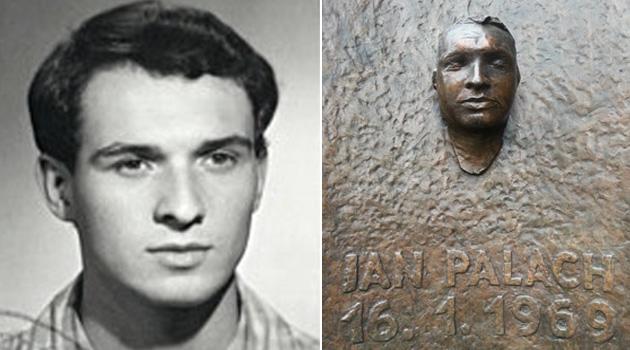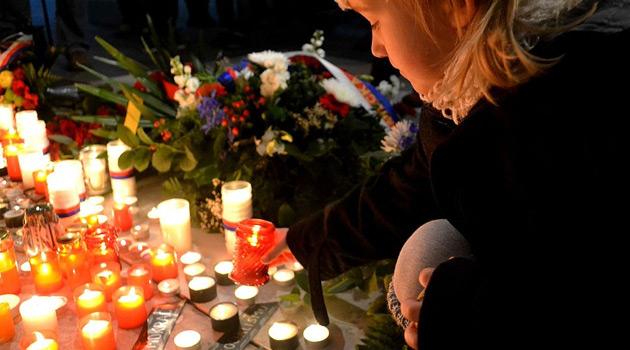Four Czech senators undertake sole official honoring of the memory of Jan Palach, who set himself on fire 52 years ago to protest the Soviet occupation

Czech Senator Miloš Vystrčil, who presides over the upper house, said yesterday that when the student Jan Palach set himself on fire on Wenceslas Sqaure in Prague 52 years ago, it was an unprecedented act in defense of freedom and an effort to lead the nation out of its unfree condition. Palach undertook his demonstration in January 1969 as an attempt to arouse people from the lethargy into which Czechoslovak society had fallen after the August 1968 occupation of the country by Warsaw Pact troops.
On the 52nd anniversary of Palach’s action, Vystrčil and three other senators laid flowers and lit candles at the location where Palach committed his self-sacrifice; a wooden cross embedded in the sidewalk that passes in front of the National Museum reminds passers-by of the exact location. The senators then laid more flowers at the memorial to Palach that is now part of a second, more modern building at the Museum complex and used to house the Czechoslovak Federal Assembly; on 17 November 2020 a sculpture entitled “The Flame” (“Plamen”) was unveiled there on a high plinth.
“I ask myself what it must have been like if there were young people who were so desperate that they went so far as to set themselves on fire in order to warn others that something was happening here that wasn’t right. I carry the memory of this with me and I am grateful that we are able to live at a time that is fundamentally different today than it was back then,” Vystrčil said.
The president of the Senate attended the act of remembrance with the first vice-president of the Senate, Jiří Růžička, vice-chair Jiří Oberfalzer and Senator Miroslava Němcová. “Whether this is enough or not – it’s always up to us how we commemorate the events that preceded our gaining our freedom,” Vystrčil said when asked by journalists why the delegation from the Senate were the only constitutional officers to commemorate Palach’s actions on the anniversary of his deed yesterday.
The 30-meter steel column that forms the base of the new sculpture has stood in front of the building of the former Federal Assembly for 40 years, but until recently very few people knew much about the history of the building on the main road. Karel Prager, who designed the pylon, counted on commemorating Palach’s action when the Federal Assembly was being completed, given its location near the site of the self-immolation.
Proof of Prager’s original intention was recently discovered in his personal archive. The National Museum has restored the pylon, which was designed as an enormous sculpture, and affixed “The Flame” by sculptor Antonín Kašpar to it.
During the 1970s, those designing this memorial to Palach kept its actual meaning to themselves. Originally a granite sculpture by Miloslav Chlupáč, also called “The Flame”, was meant to be attached to the pylon, but bureaucrats forbid that at the beginning of the 1970s.
A model of that sculpture is preserved in the National Gallery. For decades, the Czechoslovak State Emblem was instead displayed on the pylon.
Several years ago, on the Alšovo Embankment in Prague, another such sculpture by the American architect and sculptor of Czech original John Hejduk was unveiled. That memorial to Palach, called “The House of the Suicide and the House of the Mother of the Suicide“, features two large geometric sculptures of stylized flames.
In 2019, the National Museum also opened a memorial to Palach in Všetaty in the Mělník district. The Palach family home is part of it.
Leadership of Všetaty honors the memory of Palach at his family home
The memory of Palach was also honored by Mayor of Všetaty Robert Sokol and Vice-Mayor Luboš Klobása (both with Náš městys – Our Town). Near the memorial in the Palach famiy home on Smetanova Street they lit candles in the morning and laid a wreath.
There was no commemorative ceremony there this year because of the novel coronavirus pandemic. “I believe that we assessed the situation rationally and given that the number of infected people is actually increasing here, I am glad there will not be a mass gathering and that we are commemorating this in an intimate spirit,” Sokol told the Czech News Agency.
The mayor and vice-mayor were the first to light candles at the memorial to Palach yesterday. Both then visited the local cemetery, where the Palach family tomb is located and where Palach’s remains previously were interred before being laid to rest at the Olšany Cemetery in Prague.
The local officials lit more candles at the tomb and, as had been the case at the memorial, theirs were the only ones. Palach is also commemorated at the cemetery in Všetaty by a memorial entitled “In Honor of Jan Palach” (Pocta Janu Palachovi) by the academic sculptor František Janda that was unveiled in 1994.
That memorial is located near the cemetery entrance. Yesterday morning no candles had been lit there, although the remains of previously-lit candles could be found.
Sokol said there is interest among the public about the local memorial to Palach. “It attracts people here who otherwise would never come here. There has been interest ever since it opened, so people do come here and I hope they like it,” the mayor said.
The National Museum opened the memorial to Palach at Všetaty in October 2019. It includes Palach’s family home and a new building with a multimedia exhibition.
The family home has been reconstructed and is intersected by an installation called the Edge of Evil, which symbolically stops at a table that honors the Palach family. The Edge of Evil is represented by a big metal prism.
The windows of the building are darkened and one can only see outside through tiny peepholes, which symbolize the family’s separation from society. In the other, newly-built part of the memorial are the actual objects that Palach had with him when he set himself on fire on Wenceslas Square on 16 January 1969.
That section also features multimedia screeens providing historical context and facts. The exhibition also features Palach’s death mask, which was made by the sculptor Olbram Zoubek along with his statue entitled “Jan“.
